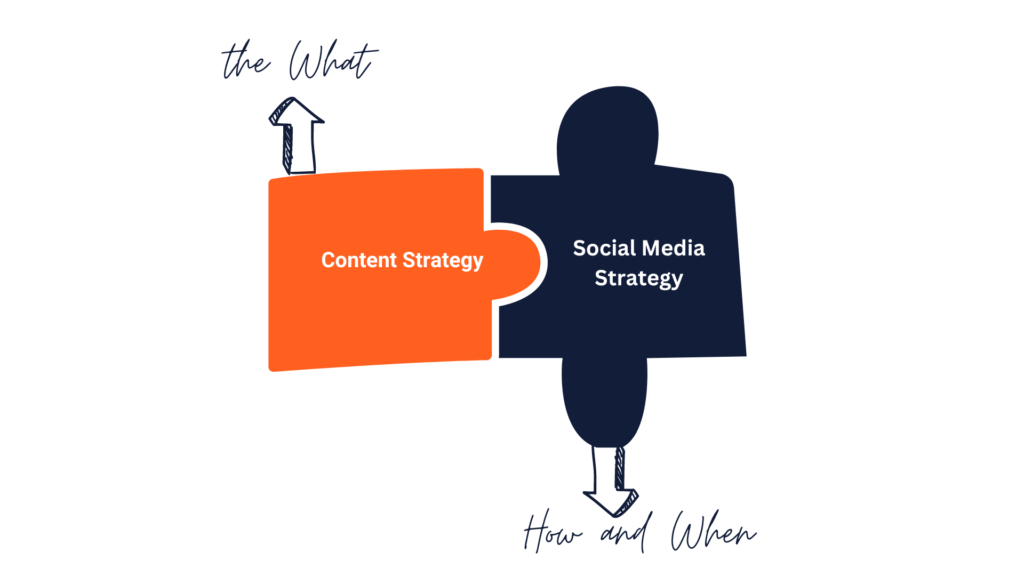Content Strategy vs Social Media Strategy
6 Steps with Examples for a Strong Content Strategy

In running an effective business, simplicity is the key. That’s why drafting a straightforward content strategy can be a game-changer, guiding your efforts and maximizing your impact without overwhelming you.
But what if I told you that it doesn’t have to be complicated? In fact, a content strategy can save you time and money by guiding your efforts and focusing your resources for maximum impact.
So, let’s break it down: a content strategy is the “what” – it’s the roadmap that outlines what you’re saying to your audience, while a social media strategy is the “how” and “when” – it’s the vehicle through which you deliver that message to your audience.
So, let’s dive into 6 practical steps with examples to help you create and execute a simple yet effective content strategy that integrates seamlessly with your social media efforts. Picture yourself as the owner of “Slow South” a candle and cosmetics company.
Step 1
Define Your Audience:
Start by identifying your target audience – who are they, what are their interests, and where do they hang out online?
For “Slow South”, a candle and cosmetic company, catering to eco-conscious consumers. Your audience might include individuals who are passionate about slow living, mindfulness, and sustainability. They prioritise natural, non-toxic products for their homes and value authenticity, craftsmanship, and simplicity.
Understanding your audience will shape the content you create and how you deliver it.
Step 2
Content Goals:
For “Slow South“, it might be to:
- Increase brand awareness among slow living enthusiasts on Instagram.
- Establish Slow South as a trusted authority in natural, sustainable candle making and cosmetics.
- Drive website traffic and boost sales of eco-friendly candle products through our online store.
Step 3
Content Pillars:
Determine key themes that align with your brand values and resonate with your audience. “Slow South” could focus on concepts like slow living, botanically infused sustainable cosmetics, natural candle making, eco-friendly home, wellness and selfcare, and brand story/values about the brand’s commitment to sustainable and ethical sourcing of ingredients.
These topics/pillars will serve as the foundation for your content, ensuring consistency and relevance across all your channels.
Step 4
Content Types:
Choose the most effective formats for delivering your message. For “Slow South“, this could include blog posts, Facebook posts, Pinterest, Instagram posts/stories, video tutorials, and email newsletters.
Varying your content types keeps your audience engaged and allows you to cater to different preferences.
Step 5
Posting Schedules:
Facebook: Aim for 3-5 posts per week, spaced out evenly throughout the week to maintain consistency without overwhelming your audience. Use your Facebook insights to detemine when to scedule your posts.
Instagram: Post at least once a day to stay visible in your followers’ feeds. Use Instagram Stories to share behind-the-scenes glimpses and interactive content.
Pinterest: Pin regularly throughout the week, focusing on visually appealing content that aligns with your brand. Aim for consistency, but don’t be afraid to experiment with timing to see what works best for your audience
Step 6
Keep an eye on what works and what doesn’t. Which post/stories or images are getting a response from your audience. Use this feedback and insights to adjust your strategy and make data-driven decisions about the next content type you create.
Free Resources:
Managing social media can be time-consuming. The good news? There are plenty of free tools and resources available to help streamline your efforts. Platforms like Buffer allow you to schedule posts in advance, freeing up time for other tasks. Canva offers easy-to-use design templates for creating eye-catching graphics, while Google Analytics provides valuable insights into your website traffic and social media performance.
By following these practical steps and useing free resources, you can create a simple yet effective content strategy that integrates seamlessly with your social media efforts. Remember, success doesn’t have to be complicated – it’s all about staying focused, consistent, and adaptable to the needs of your audience. So, why not simplify your approach and watch your business thrive?